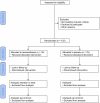Study protocol for a randomized, double-blind, placebo-controlled trial of a single preoperative steroid dose to prevent nausea and vomiting after thyroidectomy: the tPONV study
- PMID: 24015953
- PMCID: PMC3847691
- DOI: 10.1186/1471-2253-13-19
Study protocol for a randomized, double-blind, placebo-controlled trial of a single preoperative steroid dose to prevent nausea and vomiting after thyroidectomy: the tPONV study
Abstract
Background: Postoperative nausea and vomiting after general anesthesia is not only an unpleasant problem affecting 20-30% of surgical patients but may also lead to severe postoperative complications. There is a particularly high incidence of postoperative nausea and vomiting following thyroidectomy. Dexamethasone has been described as highly effective against chemotherapy-induced nausea and vomiting and has been proposed as a first-line method of postoperative nausea and vomiting prophylaxis. Despite this possible beneficial effect, the prophylactic administration of dexamethasone before surgery to prevent or ameliorate postoperative nausea and vomiting has not been established. A bilateral superficial cervical plexus block during thyroid surgery under general anesthesia significantly reduces pain. Of even greater clinical importance, this block prevents the need for postoperative opioids. Therefore, patients undergoing thyroidectomy and a bilateral superficial cervical plexus block are an ideal group to investigate the efficacy of dexamethasone for postoperative nausea and vomiting. These patients have a high incidence of postoperative nausea and vomiting and do not require opioids. They have no abdominal surgery, which can cause nausea and vomiting via a paralytic ileus. Combined with the highly standardized anesthesia protocol in use at our institution, this setting allows all known biases to be controlled.
Methods/design: We will perform a parallel two-arm, randomized (1:1), double-blind, placebo-controlled, single-center trial. Adults (≥18 years) scheduled for primary partial or total thyroidectomy because of a benign disease will be eligible for inclusion. The participants will be randomized to receive a single, intravenous preoperative dose of either 8 mg of dexamethasone in 2 ml saline (treatment group) or saline alone (placebo group). All the patients will receive a bilateral superficial cervical plexus block and standardized anesthesia. The primary outcome will be the incidence of postoperative nausea and vomiting. A total of 152 patients will be recruited, providing 80% power to detect a 50% reduction in the incidence of postoperative nausea and vomiting. Any patients who require opioid treatment will be excluded from the per-protocol analysis.
Discussion: In the present protocol, we reduced bias to the greatest extent possible. Thus, we expect to definitively clarify the efficacy of dexamethasone for postoperative nausea and vomiting prophylaxis.
Trial registration: http://www.clinicaltrials.gov: NCT01189292.
References
-
- Dolin SJ, Cashman JN, Bland JM. Effectiveness of acute postoperative pain management: I. Evidence from published data. Br J Anaesth. 2002;89:409–423. - PubMed
Associated data
LinkOut - more resources
Full Text Sources
Other Literature Sources
Medical


